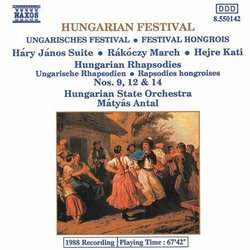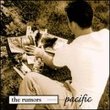| All Artists: Zoltan Kodaly, Franz Liszt, Jeno Hubay, Hector Berlioz, Matyas Antal, Hungarian State Symphony Orchestra, Albert Franz Doppler Title: Hungarian Festival Members Wishing: 0 Total Copies: 0 Label: Naxos Release Date: 2/15/1994 Genres: Special Interest, Classical Styles: Marches, Opera & Classical Vocal, Chamber Music, Historical Periods, Romantic (c.1820-1910), Instruments, Strings Number of Discs: 1 SwapaCD Credits: 1 UPC: 730099514224 |
Search - Zoltan Kodaly, Franz Liszt, Jeno Hubay :: Hungarian Festival
 | Zoltan Kodaly, Franz Liszt, Jeno Hubay Hungarian Festival Genres: Special Interest, Classical
|
Larger Image |
CD DetailsSimilar CDs |
CD ReviewsBrilliant Acoustics, Enthusiastic Playing, Great Music Leslie Richford | Selsingen, Lower Saxony | 10/23/2004 (5 out of 5 stars) "Although I am not a Hungarian and not in possession of any comparable CD, I have no hesitation in asserting that Naxos' Hungarian Festival is one of the best Naxos Cds from those early years (this recording was made in April 1988). This is an intelligent programme, played by an enthusiastic, skilful orchestra in the superb acoustics of the Italian Institute in Budapest. The recording quality is very good, and the warm-sounding instruments are captured quite brilliantly, while the Hungarian or gypsy aspects of the music are obviously second nature to Mátyás Antal and the Hungarian State Symphony Orchestra.
Taking the music in the order of the composers' birth, there is a rousing Rákóczy March, originally composed by an anonymous Hungarian musician to celebrate an 18th century Hungarian hero. The piece was orchestrated by Hector Berlioz for a concert in Pest and then grafted into 'The Damnation of Faust'. - The greater part of the CD is taken up by three of Franz Liszt's 'Hungarian Rhapsodies' in the orchestral form they were brought into by flautist Franz Doppler. They are quite wonderfully played, the clear recording and good playing making it possible to follow all the themes and melodies that make these pieces the epitome of Hungarian national music. - Hubay's 'Hejre Kati' is a rousing piece for violin and orchestra, and solo violinist Ferenc Balogh gives the piece a stirring performance which would not be at all out of place on a full-price recording. - Kodály's 'Hary Janos Suite' is of a more modern cut, but is here wonderfully played, enabling even an ancient music fan like myself to enjoy 20th century sounds. Fortunately, the liner notes, although brief, offer an explanation of the context from which the six numbers of the suite were taken. I can heartily recommend this CD to anyone interested in listening to some slightly off-the-beaten-track music." |

 Track Listings (11) - Disc #1
Track Listings (11) - Disc #1